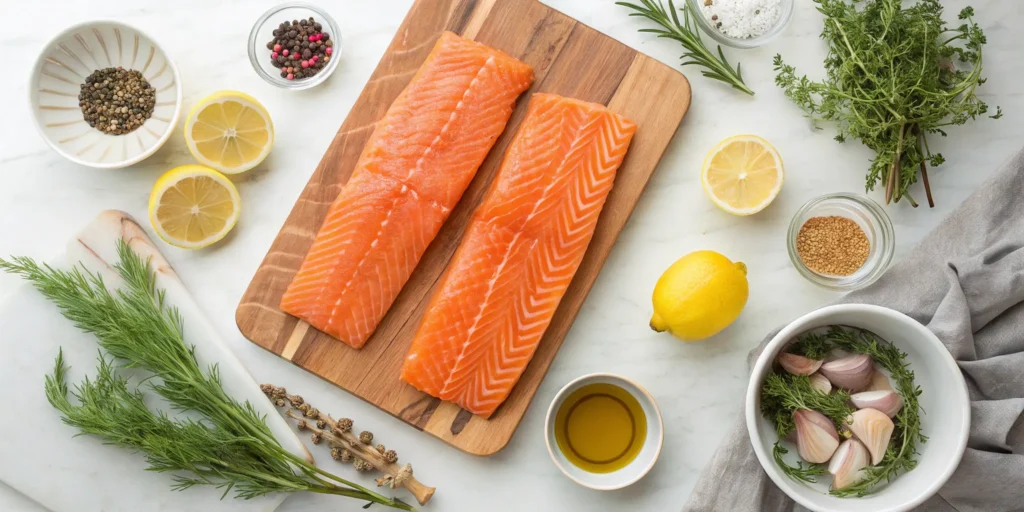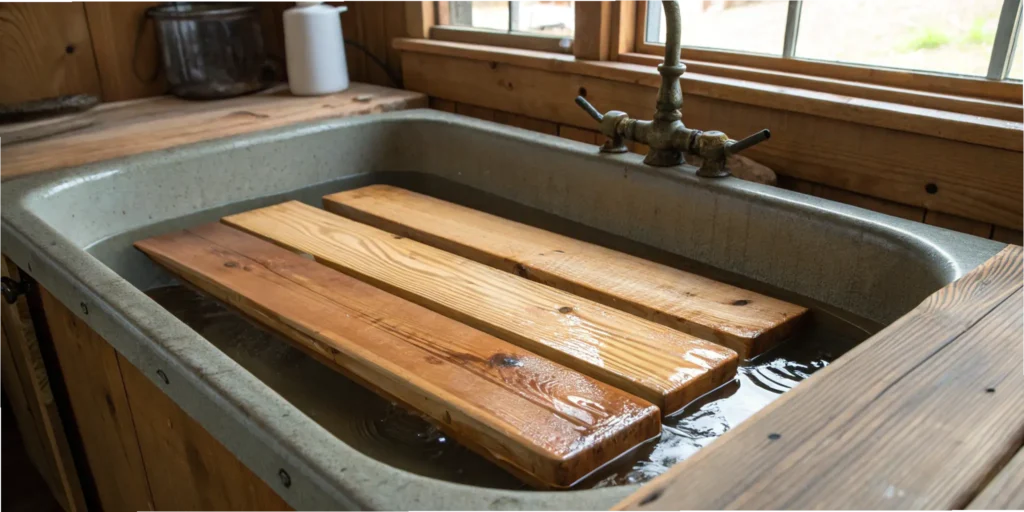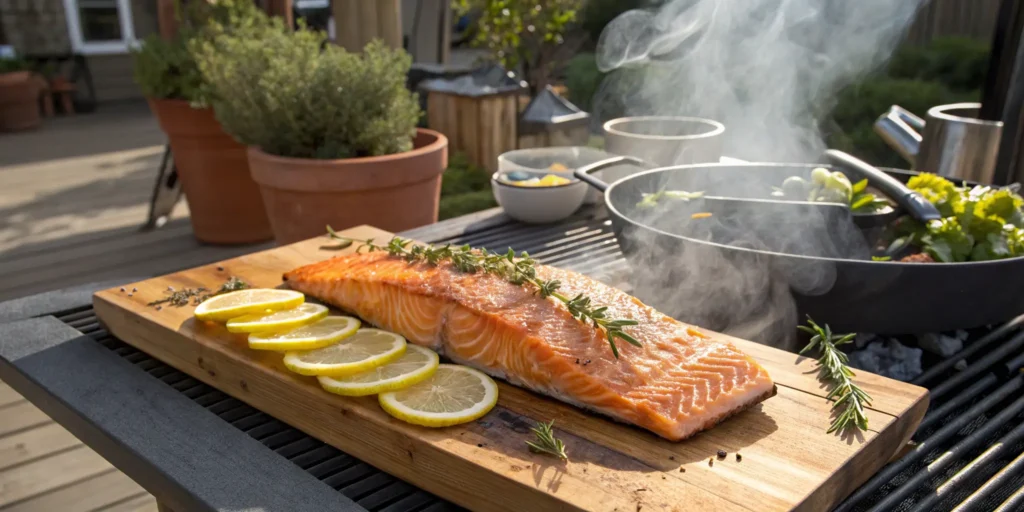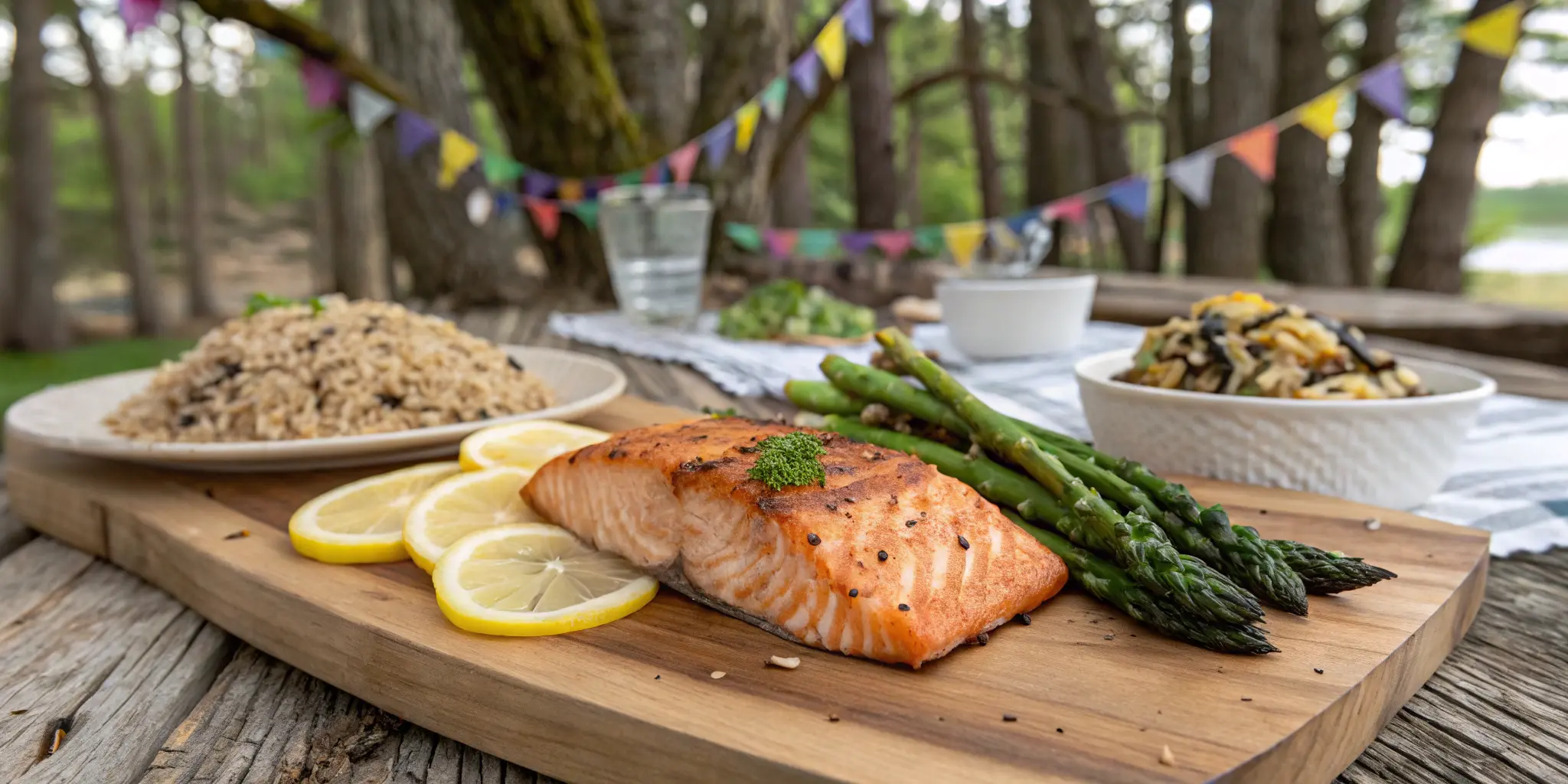Cedar Plank Salmon: 5 Easy Steps to Perfect Grilling
Table of Contents
Introduction: Elevate Your Grilling Game With Cedar Plank Salmon
Imagine a warm summer evening. The coals are glowing, the scent of cedar is drifting through the air, and you’re standing by the grill, watching a beautiful cut of salmon cook gently over a wooden plank. This isn’t just another dinner—it’s an experience.
If you’ve ever wanted to impress at a cookout without feeling overwhelmed by technique, cedar plank salmon is the way to go. It’s simple, smoky, flavorful, and surprisingly foolproof when done right. You don’t need a culinary degree—just the right steps, the right tools, and a bit of patience.
In this guide, you’ll discover how to grill cedar plank salmon in five easy, no-fuss steps. Whether you’re cooking for your family or hosting a backyard feast, you’ll walk away with a dish that turns heads and gets devoured quickly. Let’s dive into the smoky, savory world of cedar plank salmon.
Why Cedar Plank Salmon Deserves a Spot on Your Grill
There are dozens of ways to grill fish, but none offer the same blend of flavor, texture, and presentation as cedar plank salmon. Once you try it, you’ll understand why this method earns a permanent place in your grilling rotation.
The Unique Flavor Advantage of Cedar Plank Salmon
Using a cedar plank to grill salmon isn’t just for show—it’s a game-changer. The wood releases fragrant smoke as it heats up, infusing the salmon with a distinct, earthy flavor that you can’t replicate with a standard grate. The result? Cedar plank salmon that’s juicy, tender, and packed with character.
You don’t have to be a professional chef to appreciate what makes cedar plank salmon so appealing. The plank itself acts as a barrier between the fish and the flames, meaning your salmon doesn’t char or stick to the grill. That gentle, even heat keeps the texture moist and flaky—no dry bites here.
Health and Nutrition Benefits of Cedar Plank Salmon
Besides the taste, cedar plank salmon delivers serious nutritional value. Salmon is already a powerhouse when it comes to heart-healthy fats, high-quality protein, and essential vitamins. Cooking it on a cedar plank allows you to skip extra oils or heavy sauces. You’re enhancing the natural flavors without masking them.
What’s more, because cedar plank salmon cooks through steaming and indirect heat, it retains more of its nutrients than other high-heat cooking methods. This means you’re not just feeding your appetite—you’re feeding your body right.
A Versatile Dish for Any Occasion
From casual backyard dinners to special celebrations, cedar plank salmon fits every occasion. It’s elegant enough for a plated meal, yet rustic enough for paper plates at a picnic. You can dress it up with glazes and herbs or keep it simple with lemon and pepper. However you prepare it, the cedar plank guarantees a showstopping finish.
Even if you’ve never grilled fish before, cedar plank salmon offers a forgiving learning curve. Once you follow the five steps in this guide, you’ll see how effortless it can be to master this technique and deliver incredible results every time.
Step 1 – Choose the Right Cedar Planks and Salmon
When it comes to grilling success, the foundation matters. Your results depend heavily on the materials you start with—specifically, the plank and the salmon fillet itself. This step is where you lay the groundwork for bold flavor, ideal texture, and a meal worth remembering.
Selecting the Best Cedar Plank
Not all wood is created equal, and when you’re cooking with it, quality becomes even more important. For grilling, the plank must be untreated and food-safe. Look for planks labeled specifically for culinary use, typically found in the grilling section of most grocery or outdoor stores.
The ideal wood? Western Red Cedar. It imparts a smoky, aromatic character without being overpowering. Avoid anything treated with chemicals or paint, as these are not safe for grilling.
Size matters, too:
- For individual servings, a 6×12-inch plank works well.
- If you’re cooking for a crowd, go larger or use multiple planks.
Make sure your plank is thick enough to resist burning, especially if you’re using direct heat for part of the cook. A thickness of about ½ inch will keep the wood from scorching too quickly.
Soak Your Plank Before Grilling
This is one step you absolutely can’t skip. Soaking the plank in water for at least 1–2 hours is essential. It prevents the wood from catching fire and encourages flavorful steam that surrounds the salmon as it cooks.
For an extra layer of flavor, try soaking your plank in wine, beer, apple juice, or a citrus-herb mixture. Just be sure to fully submerge the plank, weighing it down if needed.
How to Choose Fresh, High-Quality Salmon
The fish you choose will directly affect the taste and texture of your dish. When shopping, go for:
- Thick, even cuts that allow for consistent cooking
- Skin-on fillets, which help retain moisture and prevent sticking
- Bright, vibrant flesh without any off-odors
Whenever possible, choose wild-caught over farmed. Wild salmon tends to have a firmer texture, deeper flavor, and better nutritional profile.
If you can’t access fresh salmon, high-quality frozen options are perfectly fine. Just be sure to thaw it slowly in the refrigerator to maintain texture.
Quick Checklist for Step 1:
- Use only untreated, food-grade cedar planks
- Soak plank for at least 1–2 hours
- Choose thick, skin-on salmon fillets
- Pick wild-caught if available for optimal taste
With your plank soaked and your salmon selected, you’ve already set yourself up for success. Next, you’ll move into prepping your ingredients and seasoning the fish—the place where creativity begins.
Step 2 – Soak the Cedar Plank Properly
Soaking your plank may seem like a simple task, but it’s one of the most crucial steps in making great cedar plank salmon. If you skip this or rush through it, you risk charring the wood, ruining the flavor, and drying out the fish. Done right, though, soaking transforms your plank into a vessel of subtle aromatics and even heat—essential to that perfect bite of cedar plank salmon.
Why Soaking the Plank Matters
When you’re preparing cedar plank salmon, the soaked wood acts as both a buffer and a flavor enhancer. Soaking prevents the plank from burning too fast, which allows your salmon to cook slowly and evenly. This process also creates gentle steam that infuses your fish with a distinct, woodsy aroma.
If you want your cedar plank salmon to turn out moist and richly flavored, don’t skip this step. The moisture in the wood ensures that the bottom of the fish won’t overcook, even if your grill temperature fluctuates slightly.
How Long to Soak Cedar Planks
Aim for a minimum of 60 minutes, though two hours is ideal for grilling cedar plank salmon. You want the wood to be saturated, especially if you’re cooking over high heat. The thicker the plank, the longer it should soak. A quick rinse won’t do the trick—this step needs time.
If you’re prepping ahead, you can soak planks in the morning and let them sit in water until it’s time to grill your cedar plank salmon in the evening. Just remember to weigh the plank down so it stays fully submerged.
Creative Soaking Liquids for Enhanced Flavor
Water works just fine, but if you’re feeling adventurous, experiment with soaking the plank in other liquids. This can subtly shift the flavor of your cedar plank salmon, giving it a new twist each time you make it.
Here are some great options:
- White wine for a bright, crisp aroma
- Apple cider for a hint of sweetness
- Beer for a rich, malty finish
- Lemon water for citrus-forward flavor
- Herb-infused water for a more aromatic profile
Each of these options adds another dimension to your cedar plank salmon, creating a more customized experience at the grill.
Tips to Get the Most From Your Soak
- Use a large container or baking sheet to soak the planks flat.
- Place a heavy object, like a bowl or can, on top to keep the plank submerged.
- If preparing multiple portions of cedar plank salmon, soak several planks at once.
- Never use hot water, as it can release unwanted resins or oils from the wood.
Avoid These Soaking Mistakes
When you’re getting ready to cook cedar plank salmon, the little things can make or break your outcome. Common mistakes like soaking too little or using the wrong type of plank can lead to flare-ups or bitter-tasting fish.
Keep these in mind:
- Don’t skip soaking—it’s non-negotiable for cedar plank salmon.
- Never reuse a plank. The wood breaks down after one use.
- Don’t soak overnight, as the plank can become waterlogged and break apart.
Once your plank is fully soaked and ready to go, your foundation is set. Now, you’re ready to dive into seasoning and marinating, where the real flavor magic for your cedar plank salmon begins.
Step 3 – Season Your Salmon to Perfection
At this stage, your plank is soaked and your salmon is prepped. Now it’s time to infuse that fillet with flavor. The way you season your fish will determine how your cedar plank salmon tastes once it comes off the grill—so this step deserves your full attention.
Basic Seasoning for Cedar Plank Salmon
Sometimes, less is more. If you’re new to making cedar plank salmon, starting simple gives you a baseline to build from.
A minimalist seasoning option includes:
- Olive oil (brushed lightly over the top)
- Sea salt
- Cracked black pepper
- Fresh lemon slices
- A few sprigs of dill or parsley
This approach allows the cedar wood and the natural richness of the salmon to take center stage. You don’t need a long ingredient list to make cedar plank salmon shine. The plank’s aroma and the smoky grill bring out flavors that require minimal help.
Flavor-Boosting Marinades and Glazes
If you want to elevate your cedar plank salmon even further, try a marinade or glaze. These additions not only enhance flavor but help caramelize the surface of the fish as it cooks.
Here’s a simple but powerful maple-Dijon glaze:
Maple-Dijon Glaze Recipe

| Ingredient | Quantity |
|---|---|
| Maple syrup | 2 tbsp |
| Dijon mustard | 1 tbsp |
| Minced garlic | 1 tsp |
| Lemon juice | 1 tbsp |
| Fresh thyme (optional) | ½ tsp |
| Olive oil | 1 tbsp |
| Salt & pepper | To taste |
Whisk everything together and brush it over the salmon about 10–15 minutes before grilling. You can also reserve a bit of the glaze to baste during cooking for more impact.
Herb and Spice Combos to Try
For cedar plank salmon, fresh herbs and spices can transform the experience. The wood already adds a layer of flavor, but the right mix brings it all together.
Try these blends:
- Mediterranean: Rosemary, oregano, lemon zest
- Asian-inspired: Ginger, soy sauce, sesame oil
- Spicy Cajun: Smoked paprika, cayenne, garlic powder
- Sweet & Savory: Brown sugar, chili flakes, cumin
You don’t need to overpower the salmon. Your goal is to complement it—and let the plank’s gentle smokiness weave everything together.
When to Apply Your Seasoning
Timing makes a difference. For dry rubs or simple herbs, you can season just before placing the fish on the grill. If you’re using a marinade or glaze, allow the salmon to sit for 15 to 30 minutes beforehand. This helps the flavors absorb and develop deeper complexity during grilling.
Be cautious with salt-based marinades. Letting them sit too long can draw moisture out of the fish, which works against the moist results you want from cedar plank salmon.
Tips to Avoid Over-Seasoning
It’s easy to overdo it when you’re excited to add flavor. But remember, cedar plank salmon already has a signature taste thanks to the grilling method. You want your seasoning to support that—not compete with it.
Here’s what to avoid:
- Too much sugar in glazes—it can burn quickly
- Over-salting—especially if using soy sauce or other salty ingredients
- Using strong wood chips in addition to cedar—it can mask the cedar’s delicate aroma
Once seasoned, your cedar plank salmon is ready for the grill. This is where the preparation pays off, and you’re only a few minutes away from savoring smoky, tender fish.
Step 4 – Master the Grill Setup
Now that your salmon is seasoned and your plank is soaked, it’s time to fire up the grill. This step is all about setting the stage so your cedar plank salmon cooks evenly, stays moist, and picks up the perfect smoky flavor. If you don’t get the heat right, you risk burning the plank or undercooking the fish—two things you definitely want to avoid.
Prepping a Gas Grill for Cedar Plank Salmon
If you’re using a gas grill, start by preheating it to medium-high heat, ideally around 400°F. Let the grill come up to temperature with the lid closed—this ensures consistent cooking and allows you to get that cedar aroma working from the start.
Once it’s hot, switch one side to low or even turn it off completely. You’ll be using indirect heat to cook your cedar plank salmon, which keeps the wood from catching fire and helps the salmon cook slowly and evenly.
Place your soaked plank directly over the unlit burner. When you put the salmon on the plank, the heat will rise around it, creating a warm, smoky pocket of flavor. Close the lid and let the magic happen.
Setting Up a Charcoal Grill for Cedar Plank Salmon
For charcoal grills, the process is a bit different but just as effective. Light your coals and let them burn down until they’re glowing red with a coating of ash. Push them to one side of the grill, leaving the other half empty. That cooler side is where you’ll place your plank.
Position your cedar plank salmon over the indirect heat zone. Keep the lid closed as much as possible to trap the smoky flavors inside. You’ll notice the cedar begins to sizzle and smoke within a few minutes, which is exactly what you want.
Just be sure to avoid putting the plank directly over the coals. Doing so could cause the wood to flare up and burn too quickly, ruining your meal.
Use a Spray Bottle for Safety
When grilling cedar plank salmon, it’s a smart move to have a spray bottle filled with water nearby. Even with a soaked plank and indirect heat, the wood can sometimes catch a small flame. A quick spray will handle that without affecting the cooking process.
Never walk away from the grill while your salmon is cooking. The plank should smolder—not ignite. You’re going for aroma and slow heat, not a bonfire.
Keep the Grill Closed for Better Results
Every time you lift the lid, you let out the flavorful smoke that’s building around your cedar plank salmon. To get that deep, wood-kissed taste, try to keep the lid closed as much as possible. Set a timer and resist the urge to peek unless absolutely necessary.
This also helps maintain a stable temperature, allowing the fish to cook gently and evenly. A consistent internal environment means fewer chances of drying out your salmon or scorching the plank.
Quick Grill Setup Tips for Success
- Preheat your grill to around 400°F
- Use indirect heat to avoid plank flare-ups
- Place plank directly on grill grates, not over flames
- Have a spray bottle ready to manage any flare-ups
- Close the lid and let the cedar plank salmon smoke slowly
With your grill dialed in and the heat just right, you’re only minutes away from a stunning, flavorful dish. All that’s left is to let your salmon cook—and know exactly when it’s done.
Step 5 – Grill and Serve to Impress
With everything in place—the cedar plank soaked, your grill preheated, the salmon seasoned—it’s time for the part you’ve been waiting for. Grilling cedar plank salmon isn’t just about cooking. It’s about creating something that looks, smells, and tastes unforgettable. This is where patience and attention pay off.
How Long to Grill Cedar Plank Salmon
Once your cedar plank salmon is on the grill, you’ll want to close the lid and let it cook gently over indirect heat. Cooking time can vary depending on the thickness of your fillet, but the average is 15 to 20 minutes.
The cedar plank will start to smolder, releasing its signature woodsy aroma. That’s when you know it’s working. Resist the urge to move the salmon or flip it—cedar plank salmon cooks beautifully by staying in place and soaking up that smoky steam.
If you’re using a glaze or sauce, this is the perfect time to brush a second layer over the top. As the salmon cooks, the glaze will caramelize slightly, creating a beautiful finish and added depth of flavor.
Know When It’s Done
Getting doneness right is key. Overcooked fish can become dry and lose its texture, while undercooked fish might not flake properly. For the best results, aim for an internal temperature of 125°F to 130°F for medium-rare or 135°F for medium.
Use a meat thermometer to check the thickest part of the salmon. If it flakes easily with a fork and the center looks opaque with a touch of translucence, your cedar plank salmon is ready to come off the grill.
Don’t forget—residual heat will continue cooking it a bit after you remove it, so pulling it off the grill just shy of your target temperature is smart.
Serving Suggestions That Wow
You’ve just grilled a restaurant-quality piece of fish. Now it’s time to present it in a way that does justice to your effort. One of the best parts about cedar plank salmon is how stunning it looks right on the plank. You can serve it directly from the wood—it’s rustic, practical, and keeps the salmon warm longer.
Here are some serving ideas that elevate your final dish:
- Serve it with grilled asparagus, wild rice, or a citrus quinoa salad
- Top with herb butter, fresh salsa, or mango chutney
- Flake leftovers into pasta, tacos, or salads
The smoky richness of cedar plank salmon pairs well with fresh greens, roasted vegetables, or anything with a light, acidic profile to cut through the richness.
Pro Tips for Picture-Perfect Results
Even seasoned grillers learn something new every time. Here are a few final tips to make sure your cedar plank salmon is as impressive as it is delicious:
- Let it rest for a few minutes before serving to lock in moisture
- Garnish with lemon wedges, chopped herbs, or edible flowers for color
- For an added touch, drizzle with a flavored oil or glaze just before serving
If you’re entertaining, consider grilling several planks at once. The aroma alone will draw guests to the table—and the visual impact of multiple sizzling planks is hard to beat.
Quick Recap – Grilling and Serving
- Grill for 15–20 minutes over indirect heat
- Aim for 125–135°F internal temp
- Let it rest before slicing
- Serve directly from the plank for a rustic presentation
- Pair with light sides to balance the smoky flavor
You’ve now nailed every step of the process, from prep to plating. With a little practice and attention to detail, you’ll be making cedar plank salmon like a pro—no stress, no guesswork, just flavor-packed results every time.
Cedar Plank Salmon Grilling Tips for Success
Grilling cedar plank salmon isn’t difficult, but a few expert tips can take your results from good to absolutely unforgettable. These pointers will help you avoid common pitfalls and fine-tune your grilling routine for consistently impressive meals.

1. Use High-Quality Planks
Not all cedar planks are created equal. Look for culinary-grade cedar specifically made for grilling. Avoid treated or stained wood from hardware stores—those can release toxins when heated. The right plank enhances the salmon’s flavor without overpowering it, giving you that perfect balance of smokiness and natural sweetness.
Before grilling, always inspect your plank. It should be free of splinters and knots. A smooth, untreated plank soaked properly is the key foundation of any great cedar plank salmon.
2. Soak Longer for Deeper Flavor
While a 1-hour soak is the minimum, soaking for 2–3 hours (or even overnight) can give your salmon a deeper cedar aroma and prevent the plank from catching fire. You can also get creative with your soaking liquid—try adding white wine, apple cider, or even beer to the water for an extra infusion of flavor.
Every step you take here influences how your cedar plank salmon will taste once it hits the grill.
3. Avoid Overloading the Plank
Tempting as it may be, don’t overload your plank with too many fillets. Stick to one large fillet or two small portions per plank. Overcrowding reduces air circulation, which can result in uneven cooking and less smoke infusion. Keep it simple and allow the cedar to work its aromatic magic.
4. Manage the Flames
Cedar planks are flammable by nature. Even when soaked, the edges might ignite. That’s normal—but manageable. Always grill over indirect heat and keep a spray bottle of water nearby. If you see flames, just give them a quick spritz.
You want your cedar plank salmon to smolder gently—not catch fire.
5. Don’t Flip the Salmon
It might feel odd not to flip something on the grill, but with cedar plank salmon, you never flip. The plank does all the work—acting as both a barrier and a flavor enhancer. By keeping the salmon skin-side down the entire time, you let it cook evenly while soaking up all that woodsy aroma.
6. Reuse with Caution
Technically, you can reuse cedar planks—but only if they haven’t charred too much. If the plank is still mostly intact, rinse it thoroughly and dry it completely before storing. But keep in mind: reused planks won’t impart the same robust flavor as the first round. For the boldest cedar plank salmon, fresh planks are best.
7. Add Aromatics for a Flavor Boost
Want to level up your presentation and flavor? Layer the plank with fresh herbs, sliced lemons, or garlic cloves before placing the salmon on top. These aromatics will steam into the fish as it grills, making your cedar plank salmon even more fragrant and flavorful.
8. Keep the Grill Lid Closed
Grilling with the lid open releases heat and smoke—two essential elements for cedar plank salmon success. Keep the lid closed as much as possible to trap that aromatic smoke and create a convection environment. This ensures the salmon cooks evenly and absorbs the cedar flavor fully.
9. Use a Meat Thermometer
Eyeballing doneness can be tricky. A digital meat thermometer takes out the guesswork and ensures your cedar plank salmon hits the perfect temperature without drying out. Always insert the probe into the thickest part of the fillet for the most accurate reading.
10. Don’t Rush the Rest
Once it’s off the grill, let your cedar plank salmon rest for 5 minutes. This helps the juices redistribute throughout the fillet, giving you that moist, flaky texture that’s the hallmark of perfectly grilled salmon.
Summary of Expert Tips
- Use culinary-grade cedar planks
- Soak longer (with wine or cider for extra flavor)
- Cook over indirect heat
- Never flip the salmon
- Add aromatics like herbs or citrus
- Keep the grill lid closed
- Let the fish rest before serving
By mastering these tips, you’ll consistently grill cedar plank salmon that stuns in both taste and presentation. Every step you perfect gets you closer to restaurant-quality results right from your backyard.
Common Mistakes to Avoid When Grilling Cedar Plank Salmon
Even if you follow most of the steps perfectly, a few common errors can sabotage your cedar plank salmon grilling experience. Being aware of these pitfalls helps you avoid frustration and get consistent, delicious results every time.
1. Skipping the Soak
One of the biggest mistakes you can make is not soaking your cedar plank long enough. Dry planks catch fire easily, which ruins the wood’s flavor and can burn your salmon. Always soak for at least one hour—two is better—to give your cedar plank salmon that gentle, smoky aroma.
2. Using Treated or Painted Wood
Not all cedar planks are created safe for cooking. Avoid any treated, painted, or chemically enhanced wood, which can release toxins when heated. Stick to food-grade cedar planks specifically labeled for grilling.
3. Placing the Plank Over Direct Heat
Putting the cedar plank right over the flames is a sure way to burn the wood and dry out your fish. Always grill your cedar plank salmon using indirect heat to prevent flare-ups and cook the salmon evenly.
4. Overcooking the Salmon
Overcooking salmon leads to dry, rubbery texture and lost flavor. Use a meat thermometer to pull your cedar plank salmon off the grill when it reaches an internal temperature between 125°F and 135°F. Remember, the salmon will continue to cook slightly after you remove it.
5. Flipping the Salmon
With cedar plank salmon, flipping isn’t necessary. The plank keeps the fish moist and prevents sticking. Flipping can cause your fillet to break apart or lose the smoky flavor.
6. Not Preheating the Grill
Starting with a cold grill means your plank and salmon won’t cook evenly. Always preheat your grill to around 400°F before adding the plank and salmon.
7. Reusing Planks Excessively
Though tempting to reuse cedar planks to save money, they quickly lose their flavor and structural integrity after one use. For best results, use a fresh plank each time you grill cedar plank salmon.
8. Using Too Much Sugar in Glazes
Sweet glazes can burn fast over heat, leaving a bitter taste. If you’re applying a glaze to your cedar plank salmon, brush it on towards the last few minutes of grilling and keep the sugar content moderate.
9. Ignoring Safety Precautions
Cedar planks are flammable. Don’t leave your grill unattended, and keep a spray bottle handy to control flare-ups.

Avoiding these mistakes will set you up for perfectly cooked, flavorful, and moist cedar plank salmon every time.
Conclusion – Enjoy the Flavor Only Cedar Can Deliver
You’ve now mastered the art of grilling cedar plank salmon in five simple, foolproof steps. From selecting the perfect plank and salmon fillet to soaking, seasoning, and grilling with care, each part plays a crucial role in creating a meal that’s as flavorful as it is memorable.
Cooking cedar plank salmon isn’t just about technique—it’s about elevating your grilling game and treating yourself to a delicious, healthy meal that brings friends and family together. The smoky aroma, the tender texture, and the beautiful presentation make every bite worth the effort.
Remember, the key to success lies in patience and attention to detail. Soak your planks thoroughly, season thoughtfully, control your grill’s heat, and let the plank work its magic. Once you taste that perfectly cooked cedar plank salmon, you’ll know it’s a grilling method worth repeating.
Ready to impress your guests and enjoy a restaurant-quality seafood experience at home? Grab your cedar plank, fire up your grill, and start cooking your own perfect cedar plank salmon today.
Frequently Asked Questions About Cedar Plank Salmon
What is cedar plank salmon?
Cedar plank salmon is a grilling method where salmon fillets are cooked on a soaked cedar wood plank over indirect heat. The plank imparts a smoky, aromatic flavor to the fish, keeping it moist and tender while adding a subtle woodsy taste.
How long should I soak my cedar plank for salmon?
For the best results, soak your cedar plank for at least 1 to 2 hours before grilling. This prevents the wood from catching fire and allows it to produce flavorful smoke that infuses the salmon during cooking.
Can I reuse cedar planks for salmon grilling?
While it’s possible to reuse cedar planks if they are still intact, it’s generally recommended to use a fresh plank for each cook. Reused planks lose their ability to impart flavor and may break apart during grilling.
What temperature should I grill cedar plank salmon at?
You should grill cedar plank salmon over indirect heat at about 375°F to 400°F. This temperature range helps the salmon cook evenly without burning the plank.
How long does cedar plank salmon take to cook?
Cooking time typically ranges from 15 to 20 minutes, depending on the thickness of the fillet. Use a meat thermometer to check for an internal temperature of 125°F to 135°F for perfectly cooked salmon.
Can I use other types of wood planks besides cedar?
Yes, other wood planks like alder, maple, or hickory can be used, but cedar is preferred for its mild, aromatic smoke that complements salmon well. Make sure any wood plank you use is untreated and food-safe.
Do I need to season cedar plank salmon?
Seasoning is recommended to enhance the natural flavors of the salmon and the cedar. Simple seasonings like salt, pepper, lemon, and fresh herbs work well, but you can also use marinades or glazes to add variety.

